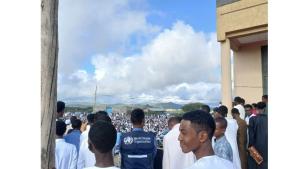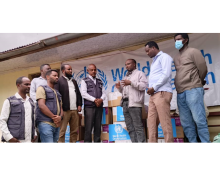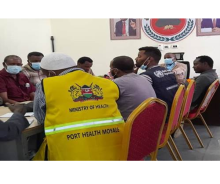How WHO helped in Moyale city fight a Mpox outbreak
On 24 May 2025, Moyale Hospital reported a suspected case of Mpox in a 21-day-old female newborn presenting with generalized skin lesions and high-grade fever, resulting from exposure to her parents. Subsequent testing confirmed Mpox virus infection in five individuals aged from less than one month to 30 years.
Moyale’s location as a high-traffic border town between Ethiopia and Kenya created heightened cross-border transmission risk. Given the rapid spread and vulnerable case profile, the Ethiopian Ministry of Health (MoH) formally declared an outbreak.
On 27 May, the World Health Organization (WHO) Ethiopia country office, in support of the government response, deployed a multidisciplinary surge team, including epidemiologists, case management specialists, infection prevention and control (IPC) experts, risk communication and community engagement (RCCE) officers, and mental health and psychosocial support (MHPSS) practitioners. The primary objectives were:
Conduct rapid outbreak assessment and situational analysis.
• Strengthen surveillance and laboratory confirmation capacity.
• Support case management and IPC interventions.
• Implement coordinated RCCE and MHPSS activities.
• Enhance cross-border collaboration with Kenyan health authorities.
WHO co-chaired daily incident management meetings with MoH, Oromia and Somali Regional Health Bureaus, and the Ethiopian Public Health Institute (EPHI). Using rapid mapping tools, the team identified high-risk transmission zones, prioritized 10 official and unofficial border points for active surveillance, and integrated Mpox case definitions into routine screening.
Case management capacity was scaled through the establishment of five isolation units. Over 30 m³ of Personal Protective Equipment, essential medicines, and Infection Prevention and Control supplies were delivered to facilities previously lacking minimum protective equipment. WHO trained health workers received targeted sessions on Mpox clinical recognition, safe isolation protocols, and case follow-up.
RCCE interventions included door-to-door contact tracing by trained community volunteers, dissemination of information via a mobile loudspeaker unit in three local languages, and targeted awareness sessions in schools, mosques, and during Eid al-Adha gatherings—reaching an estimated 92,000 people.
“The success in Moyale shows that when communities are part of the response, trust grows and results follow. This outbreak could have been far worse without that collaboration,” said Innocent Komakech, WHO Ethiopia Incident Manager for the Mpox response.
Mental Health and Psychosocial Support (MHPSS) services were embedded into the response, offering counselling to patients, families, and frontline workers. Religious leaders were briefed to counter stigma and misinformation. Notably, patient refusals of testing decreased following structured counselling sessions.
Challenges included intermittent supply chain constraints, logistical barriers to reaching remote settlements, and initial community hesitancy due to stigma and perceived economic loss from quarantine measures. However, sustained multi-sectoral coordination and cross-border engagement enabled a marked reduction in new cases.
By the end of WHO’s mission on 21 June 2025, epidemiological data showed a downward trend in reported cases, all isolation facilities remained operational, and trained local volunteers maintained community surveillance systems.
These interventions were supported by funding from the Government of Japan, the United Nations Central Emergency Response Fund (CERF), and the European Union’s Civil Protection and Humanitarian Aid Operations (ECHO).


